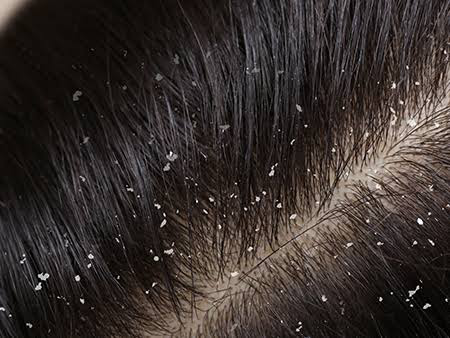Dandruff
Dandruff occurs, essentially, when small bits of dry skin are shed from the scalp. You might find these flakes in your hair or on your shoulders. Dandruff may make your scalp itchy, too. It’s a common problem, but it isn’t as simple as it seems. Dandruff is actually quite tricky to define because it overlaps with seborrheic dermatitis (a chronic form of eczema) and other skin conditions that lead to a scaly scalp.

Signs and Symptoms of Dandruff
The big tip-off that an individual may have dandruff are the patches of white flakes on the scalp, made up of dead skin, that come loose in your hair. Other signs include:
- At times, the scalp can be itchy
- Greasy or dry scales on the scalp
- Reddish scaly raised bumps along the hairline (in severe cases)
Causes and Risk Factors of Dandruff
- Oily scalp:- People with oily skin are often more prone to dandruff. The reason: A yeast called Malassezia globosa feeds on oils on the scalp. Some people’s bodies perceive this breakdown of oil as an irritant, so the scalp reacts by upping the speed at which skin cells renew, causing dandruff
- Dry skin:- If cold winter air dries out your skin all over, including your scalp, then dry skin may be the cause of your dandruff. When dry skin causes dandruff, the flakes are usually smaller and less oily
- Shampooing habits:- For those who are already at risk for dandruff, washing infrequently can worsen the condition. Taking extended breaks can lead to a buildup of oil that can lead to dandruff.
- Age:- Dandruff often begins at puberty and peaks around age 20, becoming far less prevalent among folks over 50 years old
Treatment and Medication Options for Dandruff
- Gentle shampoo:- To reduce oil and skin cell buildup, wash hair daily with a gentle shampoo, lightly massaging the scalp to loosen flakes. We recommend using Root2tip’s Stimulate and Cleanse Sulfate Free hair shampoo. It has been uniquely crafted for dry frizzy curly hair types. Mild enough for daily usage, the unique blend of aloe, ginger and plant proteins, will cleanse an oily scalp without stripping your hair.
- OTC dandruff shampoo:- If gentle shampoo is not helping, try an over-the-counter (OTC) dandruff shampoo.
- Hair Harvest Growth Kit:- A luxurious but innovative formula that will soothe and stop scalp itching. This combo has two products, Grow It Long Scalp Serum which targets the flaky or dry scalp/dandruff issue and assists in thickening your hair and Root Energizer Scalp Oil which nourishes your scalp. As a trainee trichologist our approach is scalp first. A healthy scalp is equal to a healthy hair
- Tea tree oil:- Tea tree oil also helps wash away oil, dead skin, and chemical buildup. Unblocks pores. Tea tree oil helps improve scalp health by unblocking pores. This reduces dandruff formation.
Seborrheic Dermatitis
Seborrheic dermatitis is a common skin condition that mainly affects your scalp. It causes scaly patches, inflamed skin and stubborn dandruff. It usually affects oily areas of the body, such as the face, sides of the nose, eyebrows, ears, eyelids and chest. This condition can be irritating but it’s not contagious, and it doesn’t cause permanent hair loss. Seborrheic dermatitis may go away without treatment. Or you may need to use medicated shampoo or other products long term to clear up symptoms and prevent flare-ups.

Signs and Symptoms of Seborrheic Dermatitis
- Flaking skin (dandruff) on your scalp, hair, eyebrows, beard or mustache
- Patches of greasy skin covered with flaky white or yellow scales or crust on the scalp, face, sides of the nose, eyebrows, ears, eyelids, chest, armpits, groin area or under the breasts
- Rash that may look darker or lighter in people with brown or Black skin and redder in those with white skin
- Ring-shaped (annular) rash, for a type called petaloid seborrheic dermatitis
- Itchiness (pruritus)
Causes and Risk Factors of Seborrheic Dermatitis
The exact cause of seborrheic dermatitis isn’t clear. It may be due to the yeast Malassezia, excess oil in the skin or a problem in the immune system.
Risk factors for seborrheic dermatitis include:
- Stress
- Fatigue
- A change of season
- Nervous system conditions, such as Parkinson’s disease
- Having a mental health condition, such as depression
- Immune system disorders, such as HIV infection
- Recovery from stressful medical conditions, such as a heart attack
Treatment for Seborrheic Dermatitis
In teenagers and adults, seborrheic dermatitis usually doesn’t disappear on its own without treatment. Type of treatment depends on the area of the body that is affected and how severe your condition is. The goal of treatment is to reduce the visible signs of seborrheic dermatitis and itching and redness. Treatment includes use of over-the-counter products and prescription products. Prescription products include topical antifungals, calcineurin inhibitors and corticosteroids. Ongoing maintenance treatment is often needed. You may need to use a combination of these treatments:
How to Tell the Difference Between Dandruff and Seborrheic Dermatitis
Seborrheic dermatitis and dandruff can both cause itchy, flaky skin on the scalp. However, dandruff usually presents as small, white flakes in the hair and on the scalp. In contrast, seborrheic dermatitis usually presents as defined plaques of greasy, yellow scales on the scalp, behind the ears, and on the nose, upper lip, eyelids, eyebrows, and upper chest. Dandruff is basically a mild form of seborrheic dermatitis.
Psoriasis
Psoriasis is a skin disease that causes a rash with itchy, scaly patches, most commonly on the knees, elbows, trunk and scalp. Psoriasis is a common, long-term (chronic) disease with no cure. It can be painful, interfere with sleep and make it hard to concentrate. The condition tends to go through cycles, flaring for a few weeks or months, then subsiding for a while. Common triggers in people with a genetic predisposition to psoriasis include infections, cuts or burns, and certain medications. Psoriasis is of many types but in this blog we will only talk about scalp psoriasis
Scalp psoriasis is a long-lasting (chronic) autoimmune disease (caused by your own immune system) that causes your skin cells to reproduce too quickly. It creates thick, discolored patches of skin (plaques) on your scalp and other areas around your scalp. These areas may include:
- Your hairline.
- Your forehead.
- The back of your neck.
- The skin around your ears.

Signs and Symptoms of Scalp Psoriasis
- Raised, discolored (red, brown, gray or purple) plaques with a white or silvery surface of dead skin cells.
- Plaques on most of your scalp or your entire scalp.
- Plaques along your hairline, forehead, the back of your neck or on the skin around your ears.
- Skin flakes.
- Cracks (fissures).
- Irritation or pain.
Causes of Scalp Psoriasis
Scalp psoriasis is an immune system disease. Your immune system overreacts, causing inflammation, which leads to new skin cells growing too fast.
Typically, new skin cells grow every 28 to 30 days. But in people with scalp psoriasis, new skin cells grow and move to the skin surface every three to four days. The buildup of new cells replacing old cells creates thick patches of skin.
Scalp psoriasis can runs in families, but the actual triggers are complex. Parents may pass it down to their children, and environmental exposures can include skin trauma, sunburn, medications, stress and other inflammatory or autoimmune health conditions.
Treatment for Scalp Psoriasis
There isn’t a cure for scalp psoriasis. You may have flare-ups and times where the plaques go away (remission). Treatment can provide relief for your symptoms and can include UV light or medications that can be directly applied to the lesions, injected into the lesions or taken by mouth. An anti inflammatory diet (consisting of green leafy vegetables, olive oil, oily fish) can limit your flare of scalp psoriasis.
The following chart shows the differences and similarities between dandruff and seborrheic dermatitis and scalp psoriasis
|
Characteristics |
Dandruff |
Seborrheic Dermatitis |
Scalp Psoriasis |
|
Causes by yeast overgrowth |
Yes |
Yes |
No |
|
White, flaky, skin flakes |
Yes |
Yes |
Yes |
|
Greasy scales with yellowish tint |
No |
Yes |
No |
|
Redness and itchiness |
Yes |
Yes |
Yes |
|
Can affect other oily area |
No |
Yes |
Yes |
|
Common in infants |
No |
Yes |
No |
|
Requires medical evaluation |
No |
Yes |
Yes |
|
Autoimmune disorder |
No |
No |
Yes |
|
Thick, silver or white scales |
No |
No |
Yes |
Conclusion
In conclusion, dandruff, seborrheic dermatitis, and scalp psoriasis are distinct scalp conditions with varying causes and characteristics. Dandruff is typically milder, caused by yeast overgrowth, and characterized by white flakes and mild itching. Seborrheic dermatitis involves greasy, yellowish scales, intense itching, and can affect other oily areas of the body. Scalp psoriasis, on the other hand, is an autoimmune disorder, resulting in thick, silver or white scales, redness, and itching, often extending beyond the scalp.
While this simplified comparison provides a basic understanding, accurate diagnosis and tailored treatment plans should be determined by healthcare professionals. If you suspect you have any of these conditions, seek medical advice for proper evaluation and guidance.
Visit www.root2tip.com for a range of hair care product

